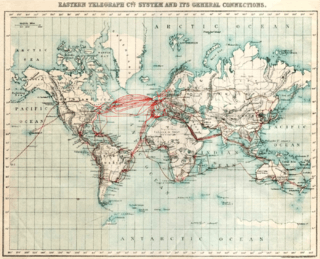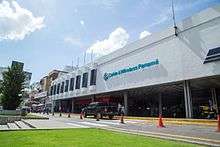Cable & Wireless Communications
 | |
| Subsidiary of Liberty Global | |
| Traded as | NASDAQ: LILAK |
| Industry | Telecommunications |
| Predecessor | Cable & Wireless plc |
| Founded | 1852 |
| Headquarters | London, United Kingdom |
Key people |
John Reid (CEO) |
| Revenue | US$ 1.753 million (2014/15)[1] |
| US$ 321 million (2014/15)[1] | |
| US$ 33 million (2014/15)[1] | |
| Parent | Liberty Global |
| Subsidiaries |
Columbus Communications Columbus Business C&W Business C&W Networks FLOW BTC Bahamas Cable & Wireless Panama (+Movil) |
| Website |
www |
Cable & Wireless Communications Ltd is a British multinational telecommunications company headquartered in London, United Kingdom with operations in Pan-America (the Caribbean and Central America). It was formed when Cable & Wireless plc demerged in 2010 to form two companies (the other being Cable & Wireless Worldwide plc).
The company operates under a number of brands, including LIME, Cable & Wireless Panama and CWC Business. In 2015, Cable & Wireless Communications purchased Columbus Communications, and has since rebranded its LIME operations under Columbus' FLOW brand.
In November 2015, Liberty Global announced it would purchase Cable & Wireless Communications.[2] The company was officially acquired by Liberty Global on May 16, 2016. It will undergo a six-month integration period into the LiLAC Group (Liberty's Latin American and Caribbean Group).[3]
History
British and Transatlantic cables and Eastern Telegraph Company (1852-1901)
The origins of Cable and Wireless Communications begin in 1852 when John Pender, a Manchester cotton merchant, joined other businessmen as director of the English and Irish Magnetic Telegraph Company. This company ran a specific point to point telegraph cable service between London and Dublin, but Pender soon began founding numerous other telegraphic cable companies to run similar point to point, national and international telegraph services. Over time Pender amalgamated these into the single company that would form the basis for Cable and Wireless Communications.[4]
Because of the early development of point to point telegraph services, Cable and Wireless's origins embrace over 50 early telegraph, radio and telecommunications companies, many of them founded by Pender.
Pender was a financier of the Great Eastern Ship which laid the first successful transatlantic telegraph cable in 1866, beginning a new era of international telegraph communications.[5]
In 1869, Pender founded the Falmouth, Gibraltar and Malta Cable Company and the British Indian Submarine Telegraph Company, which connected the Anglo-Mediterranean cable (linking Malta to Alexandria using a cable manufactured by one of Pender's companies) to Britain and India, respectively. The London to Bombay telegraph line was completed in 1870. The London to Bombay cable was the first to land at Porthcurno in Cornwall, a location which became the company’s global hub and is now home to its archive and a telegraph museum.[6]
In 1872 the three companies were merged with the Marseilles, Algiers and Malta Telegraph Company to form the Eastern Telegraph Company, with Pender as chairman.[7]
The Eastern Telegraph Company steadily took over a number of companies founded to connect the West Indies and South America, leading to a name change to The Eastern and Associated Telegraph Companies.[8]

Rise of wireless and transition to C&W Ltd (1901-1945)
From 1900 the near-monopoly on international communications enjoyed by the cable companies came under threat from the development of wireless radio technology. Marconi's Wireless Telegraph Company gradually developed a chain of ships using short-wave radio communications which could commercially compete with undersea cables. In 1924 Marconi succeeded in telephoning Australia using short wave radio and in the same year was given a contract by the British Post Office to set up circuits with Canada, Australia, South Africa and India (called the Post Office beam wireless service).
The 1928 Imperial Wireless & Cable Conference was convened to establish the best way to manage these two technologies and protect British interests. This led to a decision to merge the communications methods of the British Empire into one operating company, initially known as the Imperial and International Communications Ltd, and changed to Cable and Wireless Limited in 1934.[9][10] In 1936, Sir Edward Wilshaw was named chairman of the company.[11]
Nationalisation and privatisation era (1945-1999)
Following the Labour Party's victory in the 1945 general election, the British government announced its intention to nationalise Cable and Wireless, which was carried out in 1947.[9] The company continued to own assets and operate telecommunication services outside the UK, but all assets in the UK were integrated with those of the Post Office, which operated the UK's domestic telecommunications monopoly.[12]
In 1979 the Conservative Party government led by Margaret Thatcher began privatising the nationalised industries. Cable & Wireless was its first privatisation, with the sale of 49% in November 1981 (the remaining 51% was sold in two tranches in 1983 and 1985).[13]
Part of the privatisation included the granting of a licence for a UK telecommunications network, Mercury Communications Ltd, as a rival to British Telecom. It was established as a subsidiary of Cable & Wireless.[14][15] Barclays and British Petroleum were the other original investors. They were bought out by Cable & Wireless in 1984. Mercury Communications was first licensed in 1982 and became a full Public Telecommunications Operator in 1984.
One2One was established as the trading name of Mercury Personal Communications, a joint venture partnership equally owned by Cable & Wireless and US West International, a division of US WEST Media Group. One 2 One launched its mobile communications services to the UK market in 1993.[16]
In October 1996, Mercury was merged with three cable operators in the UK (Vidéotron, NYNEX and Bell Cable media) and renamed Cable & Wireless Communications (in which Cable & Wireless PlC owned a 53% stake).[15][17][18]
Following this, the group embarked on a major disposal programme, selling One 2 One to T Mobile in 1999,[19] then selling its stake in CWC's consumer operations to NTL in 2000 (now Virgin Media).
International expansion of C&W (1981-2006)
During this period Cable & Wireless entered several markets which remain important parts of the Cable & Wireless Communications Group.
In 1997, Cable & Wireless bought a 50% share of the Panamanian INTEL (Instituto Nacional de Telecomunicaciones).[20] The company is now called Cable & Wireless Panama.
In 2004, the group purchased a controlling stake in Monaco Telecom from Vivendi Universal.
Transition to a demerger (2006-2010)
In 2006, group chairman Sir Richard Lapthorne made the decision to split the business into two divisions : 'Cable & Wireless International' - which managed the group's telecommunications companies in various countries; and 'Cable & Wireless Europe, Asia and US' - focused on the enterprise market with a strong presence in the UK. In November 2009, the Cable and Wireless plc board announced its intention to demerge.[21]
Pan-America focus (2010 to date)
The companies demerged on 26 March 2010 into Cable & Wireless Communications (formerly Cable & Wireless International) and Cable & Wireless Worldwide (formerly Cable & Wireless Europe, Asia and US).[22] Cable & Wireless Worldwide was subsequently purchased by Vodafone on 27 July 2012.[23]
Cable & Wireless Communications in 2010 had a global portfolio of telecoms operators in small and medium-sized markets. The company’s Board determined that it would be difficult to generate the economies of scale needed in the telecoms industry from such a diverse portfolio and so determined to focus the business in the Pan-America region where it owns a number of businesses in the Caribbean and Panama.
Between 2010 and 2013 the company divested a number of businesses including in Bermuda,[24] the Channel Islands and Isle of Man, Maldives, South Atlantic[25] and Macau.[26] The company also purchased a 51% shareholding in The Bahamas Telecommunications Company on 7 April 2011.[27]
In 2014 Cable & Wireless Communications sold its stake in Monaco Telecom to the French entrepreneur Xavier Niel.[28]
On 17 November 2015, Liberty Global confirmed it had made an offer to buy the company.[2] Both companies reached an agreement on the offer in February 2016.[29]
Operations
In the Pan-America region Cable & Wireless Communications owns 14 businesses in the Caribbean and has a minority stake in TSTT in Trinidad. In Central America it owns 49%, and has management control, of Cable & Wireless Panama, the leading full service telecoms business in Panama.

Panama
Its Panama business, which trades as Cable & Wireless Panama, is a provider of mobile, fixed line, broadband and pay TV services in that country. They also provide telecoms services to enterprises and governments.
Caribbean
In the Caribbean, Cable & Wireless Communications trades as FLOW, except in The Bahamas where the business is branded BTC. It is a full-service telecoms provider and is the leader in most of the markets it serves and services it provides.
Cable & Wireless Communications also owns a minority stake (49%) in Telecommunications Services of Trinidad and Tobago (TSTT).
Seychelles
Cable & Wireless Communications operates in the Seychelles as Cable & Wireless Seychelles.
See also
References
- 1 2 3 "Results For the Year Ended 31 March 2015" (PDF). Cable & Wireless Communications. Retrieved 29 March 2016.
- 1 2 "Liberty Global to Acquire Cable and Wireless in $5.3 Billion Deal". Bloomberg. 17 November 2015. Retrieved 17 November 2015.
- ↑ Completed acquisition of CWC by Liberty Global
- ↑ Ken Beauchamp, History of Telegraphy (London: Institute of Electrical Engineering, 2001) p.167f
- ↑ "History of the Atlantic Cable & Submarine Telegraphy - Cable & Wireless". atlantic-cable.com. Retrieved 26 March 2015.
- ↑ Porthcurno Telegraph Museum. "Porthcurno Telegraph Museum". porthcurno.org.uk. Retrieved 26 March 2015.
- ↑ "History of the Atlantic Cable & Submarine Telegraphy - Cable & Wireless". atlantic-cable.com. Retrieved 26 March 2015.
- ↑ "History of the Atlantic Cable & Submarine Telegraphy - Cable & Wireless". atlantic-cable.com. Retrieved 26 March 2015.
- 1 2 "History of the Atlantic Cable & Submarine Telegraphy - Cable & Wireless". atlantic-cable.com. Retrieved 26 March 2015.
- ↑ "Evolution of Cable and Wireless Limited (1928 - 1934)". fundinguniverse.com. Retrieved 30 July 2012.
- ↑ "Sir Edward Wilshaw". Montreal Gazette. 4 March 1968. Retrieved 7 August 2013.
- ↑ Robert A. Brady, (1950). Crisis in Britain. Plans and Achievements of the Labour Government. University of California Press., on nationalization 1945-50, pp 284-306
- ↑ "Biz/ed - 1980s Key Facts - Biz/ed". bized.co.uk. Retrieved 26 March 2015.
- ↑ Non BT boxes in the UK
- 1 2 History of Mercury Communications fundinguniverse.com
- ↑ "Cable & Wireless Communications: Our History". Retrieved 8 April 2012.
- ↑ Mercury's £5bn merger
- ↑ Mercury's pounds 5bn merger with cable firms heralds huge telecoms indu stry shake-up Published : Independent, by Chris Godsmark and Mathew Horsman, 23 October 1996
- ↑ Business: The Company File: One 2 One sale agreed BBC, 6 August 1999
- ↑ Cable & Wireless in Panamanian deal
- ↑ Cable & Wireless confirms demerger Investors Chronicle, 6 November 2009
- ↑ Cable & Wireless demerger takes the FTSE 100 to 101 BBC, 26 March 2010
- ↑ "Welcome to Vodafone - Cable & Wireless Worldwide Acquisition". Vodafone. Retrieved 2 July 2013.
- ↑ "Cable & Wireless Communications divests Bermuda business and announces Share Buyback". Cable & Wireless Communications. 23 February 2011. Retrieved 2 July 2013.
- ↑ "Completion of the Monaco & Islands Disposal" (PDF). Cable & Wireless Communications. 3 April 2013. Retrieved 2 July 2013.
- ↑ "Completion of Macau Disposal" (PDF). Cable & Wireless Communications. 20 June 2013. Retrieved 2 July 2013.
- ↑ "Cable & Wireless Communications plc Completes Purchase of Bahamas Telecommunications Company" (PDF). Cable & Wireless Communications. 7 April 2011. Retrieved 2 July 2013.
- ↑ Sandle, Paul (25 April 2014). "Cable & Wireless sells Monaco Telecom stake to Xavier Niel". Reuters. Retrieved 1 March 2016.
- ↑ Dyer, Renae (22 February 2016). "Cable & Wireless reveals further details on Liberty Global takeover". Digital Look. Retrieved 1 March 2016.